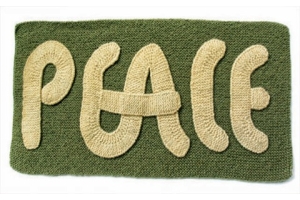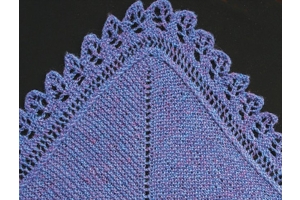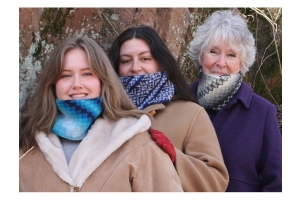Blog #1 Meg Swansen on Books, Bohus Knitting, and her Bohus Sweater Collection

You know how, when someone gives you a beautiful brand-spanking-new journal, you admire it and thank the giver kindly. A few days later you take it out and stroke the cover, admire the sewn binding, and open to the first page with pen in hand. But hesitate. Then find a pencil instead, in case you want to erase the first word/sentence. Next you turn to the second page which, somehow, seems less intimidating than the first. Well, that is how I feel about initiating this online journal... how and where to begin.
For the past several months, as I continue to import new knitting books from Europe, I have been awash in Swedish Kronar, British Pounds and Euros, and have managed to locate the symbols £ and € on my keyboard. Each of the new foreign titles celebrates knitting traditions from their respective countries, with both historical/traditional perspectives plus occasional glimpses of contemporary adaptations.
The upshot being that hand-knitting has again become a major force in Europe (not that it ever went away). In the middle of the last century, America was practically bereft of knitting shops, knitting magazines, and knitting books by U.S. authors. We had to look to the UK for the few books that were (to our knowledge) available: Gladys Thompson’s Guernseys, Jerseys & Arans and Mary Thomas’s two timeless old knitting books, plus the two Marianne Kinzel Modern Lace Knitting books (all five of the above are still extant, thank goodness).
American knitting books began to appear slowly in the late 1960s with Barbara Abbey’s 101 Ways to Improve Your Knitting, and Mary Walker Phillips’ Step-by-Step Knitting. Then - ta-da - in 1968 Barbara G. Walker’s seminal Treasury of Knitting Patterns appeared and we were off and running(ish). “ $10, and worth thribble the money.” wrote Elizabeth in Newsletter #22, (and, thribble the money is just what it costs 46 years later!).
We (American knitters) crept forward through the ‘70s, slowly gaining ground. As we approached the millennium, the popularity of hand-knitting rose significantly in the US as it sank in Europe. Not being a political or social analyst, I cannot explain it. My theory is: In the midst of everyone working so hard and striving for upward mobility – the beginning of the DIY movement was a demonstration of a yearning for simpler times, for something ‘real’; something handmade; a creative outlet; the comfort of methodical, repetitive movements and the feel of wool in your hands. Hand-knitting certainly satisfies all of those hungers, and plenty more besides. Of course, one mustn’t overlook the passionate excitement of knitting a new design - when words like ‘soothing’ and ‘comfort’ go out the window, to be replaced by ‘riveting’ and ‘thrilling’. However, the resulting warm and lovingly-made garment is the same.
At present - largely thanks to social media - in both Europe and the U.S. we are supplied with a plethora of outstanding hand-knitting books, and an enormous variety of 100% wools with which to knit the designs therein. Isn’t it marvelous that we are all here for this particularly industrious knitting period?
I hope to post a little something every other week or so in varied formats (video, writing, images) and on varied subjects, including knitting techniques, show and tell discussion of designs, archival documents, book reviews, and memoirs/stories.
Books from Europe:
•Sweden, are you aware of the splendid new Bohus Knitting book by Viveka Overland. It includes specific instructions for some sweaters which are totally new to us Bohus-obsessed American knitters, coming soon.
•Estonia, multiple lovely lace titles, the newest being Knitted Shawls of Aasa Joelaid, plus the spectacular Muhu Island which covers multiple needlework traditions of Estonia (alas, now unavailable with no reprint in sight. Search for the few businesses still have copies.)
•Latvia, the book, Mittens of Latvia by Maruta Grasmane, has just been translated into English and our first shipment arrived last week.
•Netherlands, for a comprehensive book on the Swedish discipline of Twined Knitting: So Warm by Carla Meijsen. Plus the wonderful book Dutch Traditional Guernseys, Sweaters from 40 Villages by Stella Rhue
•Great Britian, for the awe-inspiring Shetland Textiles 800 BC To the Present; two Kate Davies titles, Colours of Shetland and Yokes; plus Knitsonik by Felicity Ford.
•And, of course, our newest Schoolhouse Press title, In the Footsteps of Sheep is written by Welsh-born Scot Debbie Zawinski, and published here.
However, the influx of ideas from the USA in particular, with knitting podcasts and of course Ravelry, has revived the interest of some of us oldies as well as inspiring younger folk. Thank you for telling me about Bohus (I followed a link from the Heartland podcast) and look forward to seeing the difference from the old Scandinavian knitting we used to do.
Cherie Cornick, you can obtain Bohus kits directly from Sweden: http://www.angoragarnet.com/en/bohus-knitting/the-collection-20556063
and you may purchase Swedish-approved Bohus kits in the US as well from:
https://www.etsy.com/shop/KIMMETCROFTFIBER





